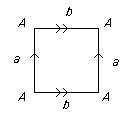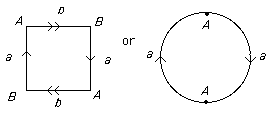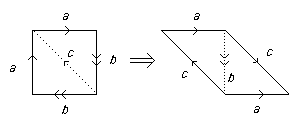Course MT4521 Geometry and topology
Planar models
To work with more complicated surfaces we use a more systematic way of describing how to make them.
Definition
A planar model of a compact surface is a disc whose boundary is a 2n-gon whose edges are identified in pairs.
Remarks
- If we have a polygon with some unidentified edges then this represents a surface with some "free edges" (and not compact).
- We can describe the planar model by labelliing the edges with letters and choosing a direction to go round the boundary and then reading off the edges as we go: putting an inverse on any edge we meet in the "opposite direction". This gives an edge-word for the planar model.
Examples
- For the torus we have
 with edge word aba-1b-1
with edge word aba-1b-1
Note that all four corners of the square get identified to the same point.
- For the Klein bottle we have
 with edge word aba-1b
with edge word aba-1b
Again all four corners of the square get identified to the same point.
- For the Projective Plane we have
 with edge word abab or a2
with edge word abab or a2
In this case the corners of the square get identified to a pair of points.
- A cylinder has edge word aba-1c and the Möbius band has edge word abac
- When we make a 2-holed torus we remove discs from tori with edge words aba-1b-1 and cdc-1d-1 to get surfaces with holes: aba-1b-1e and cdc-1d-1f which we then join together to get a model with planar word aba-1b-1cdc-1d-1

More generally:
Given planar models for surfaces S1 and S2 with edge words w1 and w2 , the edge word of a planar model for the connected sum is the concatenation w1w2 .
- The Klein bottle (again)
Joining two Projective Planes with edge words a2 and b2 gives a planar model with edge word a2b2 which is different from that in example 2 above.
However, one can manipulate as follows. 
So the edge word a2b2 becomes aca-1c which is equivalent to the one above.
It follows that it may be hard to recognise what surface is represented by a given edge word.
JOC February 2010
 with edge word aba-1b-1
with edge word aba-1b-1 with edge word aba-1b
with edge word aba-1b with edge word abab or a2
with edge word abab or a2 
